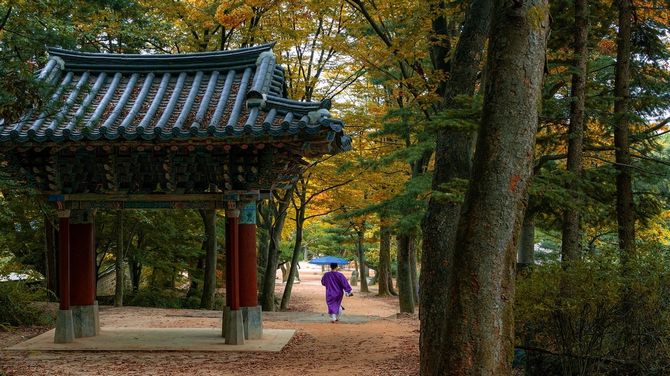South Korea is a fantastic travel destination. Along with Japan, it is one of the best destinations in Asia with a mix of everything. Tourist attractions in South Korea comprises of its traditional heritage sites, korean style houses, ancient temples, hi-tech cities filled with sky scrappers, art galleries, museums etc
Hikers, cyclists, beach lovers, history lovers, culture vultures and couples all have something to enjoy here in South Korea. With one of the world’s exceptional public delivery systems, it’s far incredibly smooth to get around.
With so much to choose from this became a hard listing to make. But, we have managed it. Here are our Top Ten Things to Do in South Korea.
Top 10 Tourist Attractions in South Korea
1. Busan
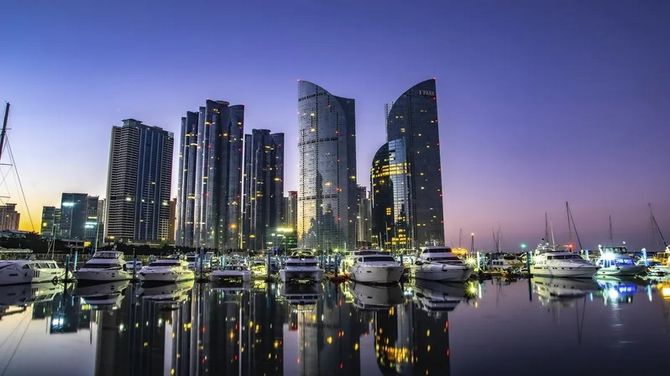
Busan is Korea’s 2nd largest city and is located to the south of the country. It is famous for its excellent beaches, but there is more to the city than just the sea and sand. There are temples, museums, mountain hiking, and cultural sites for visitors to discover too, as well as plenty of good restaurants and bars.
There are three main beaches in Busan. These are Haeundae Beach, Songjeong Beach, and Gwangalli Beach. All have nice, soft, clean sands and safe waters to swim in.
Haeundae is the most popular so those looking for somewhere quieter may wish to go elsewhere. Gwangali Beach is our recommendation. It is less crowded than the other two and is especially beautiful at night when the nearby bridge is lit up. All three beaches have plenty of shops and restaurants nearby.
Busan has some excellent hiking trails nearby. Our recommended choices are the Geumjeong Fortress hike and Seokbulsa Temple.
The fortress hike is 9 km long and takes up to 4 hours. It has impressive views of the city and takes visitors past the ruins of the Geumjeong Fortress. Seokbulsa Temple can be reached by cable car. From the station, it is a 90-minute hike to this beautiful old temple. Keep an eye out for the impressive statues carved into the side of the mountain.
A popular destination is Gamcheon Cultural Village. This charming little village is full of brightly colored houses and narrow streets. It is an excellent place to have a walk around with a number of traditional shops and cafes. Some of the houses have been turned into small art displays. A must-visit for people heading to Busan. Bring a camera and you can take some excellent photos of this picturesque part of the city.
There is far too much to see in Busan for one article, so we will just finish with a short mention of the museums. There is a number to visit in Busan.
The Busan Museum is arguably the best of the bunch. This museum tells the history of Busan with a number of interesting displays. It is great for kids as it is very hands-on and interactive. There are opportunities to have a feel of relics from the past and try your hand at making traditional handicrafts. An excellent place to spend an afternoon.
2. Geoje Island
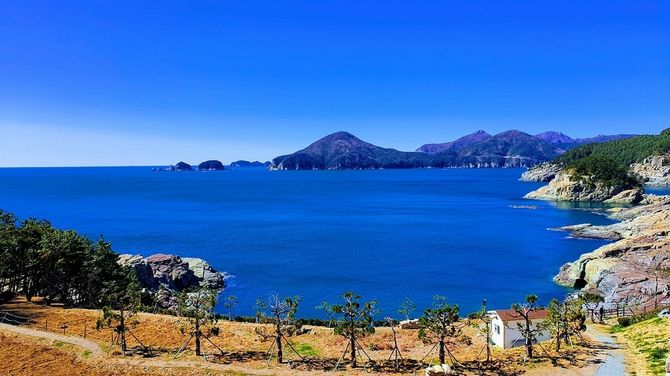
Geoje is Korea’s second biggest island. The largest settlements are Okpo and Gohyeon. Most tourist attractions lie between these two towns. The main attraction of Geoje Island is its stunning coastline. The coastline is full of beautiful, golden sand-covered coves and rugged cliffs.
The island is covered with hundreds of different hiking trails. There isn’t really a recommended hiking route, all are excellent and offer some great views of Geoje’s natural beauty.
However, hiking isn’t the reason we included Geoje in our Top Ten. The main reason to come to Geoje is to take a boat trip to the nearby island of Haegeumgang. This is a small, rocky island surrounded by tall, imposing cliffs. It looks like something from a Jurrasic Park movie with a tiny gully leading through the island.
The tour boat will actually pass through this small passage through the island before entering a sea cave. This is a must-do if you visit Korea.
All tours to Haegeumgang make a stop at Oedo Island too. It is privately owned and is home to Oedo Botanica. This is a botanical garden. It is a nice diversion for a couple of hours. The walk around is pleasant, and the gardens are very beautiful. The gardens comply with a decent valley that is surrounded via way of means of sheer cliffs.
Haegeumgang Island is the reason why Geoje is in our top ten. It is excellent. Geoje is easily accessible as it is connected to Busan via a bridge.
3. Gyeongju
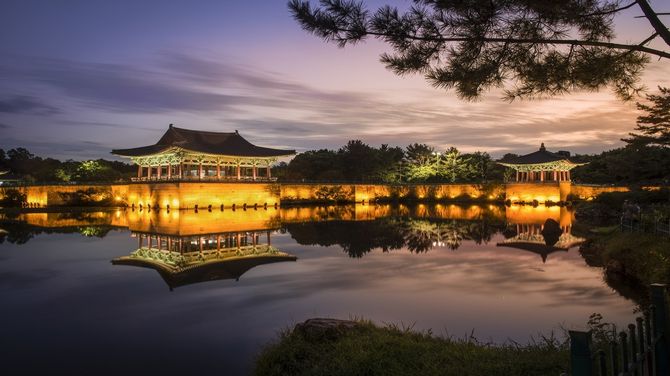
This historic city was the capital of the ancient Silla kingdom between 50 BC – 935 AD. It is one of South Korea’s most important historical sites with a number of archaeological discoveries.
Archaeological digs and excavations are still continuing to this day. There are 4 UNESCO world heritage sites in Gyeongju and this has led to it becoming one of Korea’s most popular tourist sites.
Despite becoming increasingly popular with tourists, Gyeongju still retains its charm. It lacks the usual money-grabbing attempts many tourist destinations suffer from. The site is not highly-frequented by foreign travelers but is easily accessible and the sites all feature English information signs.
With four world heritage sites and a staggering amount of historical places to view, it is easy to spend a full day in Gyeongju. We recommend hiring a bicycle for the day from one of the many stores near the train station. This is an excellent way to get around.
Now onto the sites. Whilst cycling around Gyeongju you will see a huge number of large, grassy mounds. These are the royal tombs where kings, queens, princesses and other Silla royals are buried.
There are hundreds of these tombs to walk around and explore. The most historically important are in Tumuli Park, one of the tombs inside is open to the public to enter. There is a small admission charge to enter Tumuli Park. However, if you don’t want to pay, there are many tombs outside of the park which are free to view and walk around.
The Gyeongju Museum is a must-visit. This excellent establishment details the history of the Silla Kingdom and contains an Aladdin’s Cave of historical artifacts and treasures excavated from the site. Highlights include a giant, beautiful, ancient bell and a gold crown. 15 minutes away from the museum is Cheomseongdae Observatory. This was built in 634 and is the oldest observatory in the Far East.
A highlight is the beautiful Bulguksa Temple. This is reached by regular buses. It was built in the 8th century and is considered one of the most beautiful temples in South Korea. A trip to Gyeongju isn’t complete without visiting Bulguksa Temple.
Gyeongju has a huge collection of historical sites and tombs to visit. Far too many to list here. Before we move on to the number one place to visit in Korea, here is a short list of other places to visit in Gyeongju. Seokbinggo Ice Storage house, the foundations of Banwol Fortress, Gyeongju National Park, Seokguram Grotto and more.
The best way to find out just how much Gyeongju has to offer is to visit yourself. Believe me, you won’t be disappointed. You can get to Gyeongju via regular buses from Busan which takes approximately an hour.
4. Seoul

The capital of Korea with a population of nearly 12 million people. It is a busy, bustling, vibrant city with plenty to see and do for visitors. One of the world’s major cities, Seoul has everything a traveler would want. Hundreds of excellent restaurants, brilliant shopping, great nightlife, and scores of attractions to visit. It is a must-visit for anybody.
The highlight of Seoul without a doubt is its five royal palaces. Gyeongbok-gung palace was the seat of power for centuries. The Japanese destroyed large parts of it, and it has been expertly restored to its former glory.
The grounds hold two museums; The Korean Folk Museum, and the amazing Joseon Palace Museum. Changdeok-gung palace is considered a UNESCO World Heritage Site. This large palace is arguably the most impressive of the five and is a very beautiful building. Access to Changdeok-gung is by guided tour only.
An unusual palace is Deoksu-gung. This palace is from the 15th century, and its architecture is a fusion of Eastern and Western designs making it unique among the five palaces.
Changgyeong-gung is the fourth palace. This impressive structure is one of the main palaces from the Joseon Dynasty. Finally, Gyeonghui-gung is a 17th-century palace that was largely destroyed during the Japanese colonial era. It was expertly restored in the 1980s and is now open to the public.
If temples are of interest to you then Seoul won’t disappoint. It is home to four important temples and shrines. Jongmyo Shrine located near Changgyeong-gung palace is the most famous. However, our most recommended is Inwang Temple located on Mount Inwang. This Instagram worthy temples offers some excellent views and photo opportunities.
Other places to visit include Bukchon, a historic district containing 900 traditional houses, and Seodaemum Prison which is now a museum, not for the faint of heart. If you want a good view of this sprawling city then N Seoul Tower is your designation. This was once the tallest tower in Asia and offers some breathtaking views of the city.
5. Jeonju
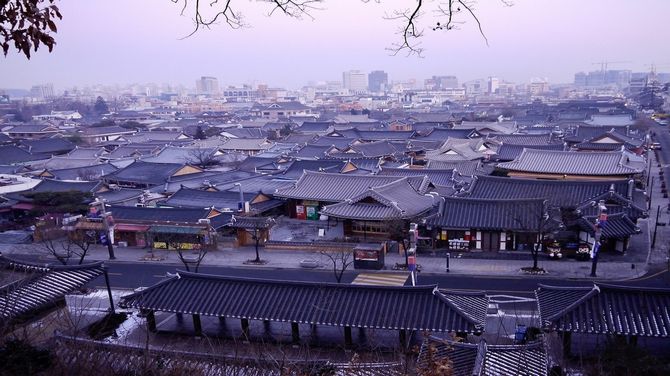
Jeonju is a historic city that was once the capital of the Joseon Dynasty. It is now a picturesque, charming city filled with art galleries, museums, ancient temples, and historical sites. The city is easily accessible by bus from both Seoul and Busan.
For people looking to experience Korean culture, visiting Jeonju Hanok Village is a must. Hanok is a traditional Korean-style house. The village contains dozens of these which were constructed between 1392-1910. It is a lovely place to have a stroll soaking in the vibe and atmosphere. As well as viewing the houses, you can also experience other aspects of Korean culture.
You should definitely sample some Korean alcohol or try your hand at making some handicrafts. Nearby is Ohmockdae. This is a small hill with a pretty house on top. It is an excellent place to get a view of the city.
For museums, there are three major ones to visit. The Jeonju History Museum is an excellent establishment that tells the history of the region, and its role in shaping Korea. It contains ancient relics and cultural items.
The Hansol Paper Museum is also very interesting. The museum tells the history of paper making from its origins in Ancient Egypt to its role in Korean culture. It may sound dull, but the exhibits inside are well done, the staff is friendly, and it is more interesting than it sounds.
There are different workshops available, and you can make some paper yourself. The third major museum is the Wine Museum. Jeonju is known for its excellent wine and this museum details the history of Korean wine and liquor making.
Jeonju is a lovely place for a day trip. It is a really pleasant city and many of the attractions are within walking distance. If you are visiting Korea be sure to stop by for a day. You won’t be disappointed.
6. Cycle the Four Rivers Trail
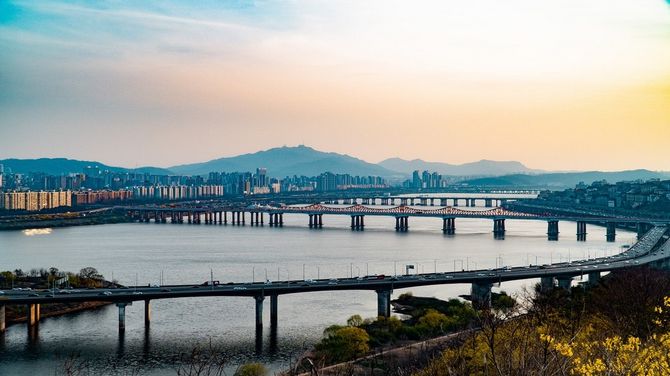
The Four Rivers Bike Trail is a series of bike trails along 4 of Korea’s rivers. The main and best route is from Busan to Incheon. It is 630 km in length and one of the best ways to see this beautiful country is to see it by bicycle.
There are four major trails and the Busan to Incheon route covers three of them. Before taking the trail you should definitely buy a “cycling passport” from a bicycle certification center.
Along the route, you will pass points where you can stamp your passport. Once you have cycled either the four main routes or from Busan to Incheon, you send your completed passport away and receive a medal and certificate. This is a nice souvenir of the journey.
The first ride stretches from Busan to Andong, passing through the city of Daegu. It is the longest of the sections of the trail. This section can be completed in four days. The full Busan to Incheon route covers the majority of this trail. It starts at the Eulsukdo Estuary. The entire trail can be completed in on average 9 days.
It is a difficult trail in parts. The most strenuous is the 100 km Saejae Mountain path. This can be very tough as it features a number of uphill sections. Despite its difficulty, the Four Rivers Trail is rewarding. You can get some stunning views on the trail and the ride takes you through some of Korea’s best cities. If you are not pushed for time it is recommended to take things slow.
Stop off at cities such as Busan, Daegu, and Seoul when you reach them and spend a couple of days enjoying the sights before continuing. After all, it isn’t a race. Although some may like to challenge themselves to take the trail as fast as they can, we recommend the opposite. By rushing you will miss out a lot of what the bike trail and Korea have to offer.
The paths are well paved so other than the uphill sections, it is a joy to ride. As it passes through or close to major towns and cities there are plenty of places to sleep along the way, so you don’t need to worry about finding a room for the night. Likewise, there are plenty of places to eat on or near the trail.
The Four Rivers Trail is one of the highlights of Korea and one of the world’s best cycling paths. We can think of no better way to experience the beauty, culture, and people of Korea than by cycling the entire length of it.
7. Chuncheon
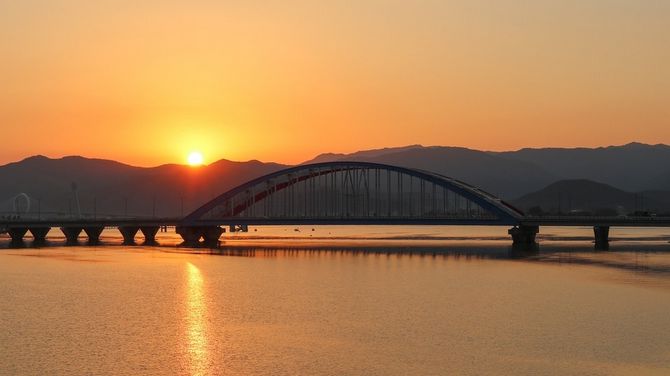
Around 70 minutes away from Seoul, Chuncheon is a nice city to go to escape the hustle and bustle of the capital. It is a small place surrounded by valleys, rivers, and hills. As such, it is a place to come for outdoor activities and to explore Korea’s beautiful countryside. It is easy to get to with buses departing from Seoul every 15 minutes.
The city itself sits in a valley and there are many excellent hiking routes. Bong Ui Mountain is probably the most popular hike. This small mountain is near the Soyang River. At 925 feet high, it is a relatively easy but rewarding climb. There are a number of different trails leading to its peak. All of which are nice, leisurely hikes with some attractive views and pretty scenery.
At the head of the river lies Soyang Lake and Soyang Dam. This is a fun place to visit. Aside from its natural beauty, you can take boat rides around the lake. As a bonus, check out the food stores on the shore which sell an abundance of unusual treats including fried grasshoppers.
If you visit Soyang Lake, be sure to take a ferry to Cheongpyeong-a temple. This is considered to be one of Korea’s best temples and dates to 949. The path to the temple is also very beautiful.
Also, on the Soyang River is Jungdo Island. Regular ferries take visitors here. You can rent a bicycle to explore this island where you will see old, traditional houses and some lovely natural scenery. You can even rent a hunt and spend the night here which is worth doing if you have a day spare.
8. The DMZ
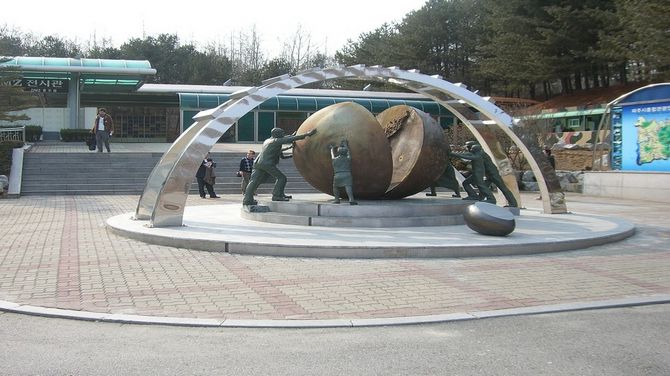
A trip to The DMZ is a must-do in Korea. Established in 1953, the DMZ straddles the border between North and South Korea and is the closest most people will come to visit an active war zone.
Even the journey into the DMZ is an adventure in itself. Visitors will travel past guard towers manned by soldiers keeping an eye on the North, through checkpoints, past tank traps and witness military vehicles trundling past. There are a number of different tours to the DMZ offered, all of which take visitors to different sites. Here are some which you can visit.
Dora Observatory is on most group’s itineraries. This lookout post sits on top of Mount Dora and looks out across the DMZ. Telescopes are set up for visitors to use allowing people to gaze across at North Korea.
Visible from Dora Observatory is Propaganda Village, the famous North Korean flagpole, and on clear days, Kaesong Village. People can also see military sites between the countries such as a number of guard and observation posts.
Dora Observatory is the site where psychological warfare is conducted from. Music is blasted out across the border at all hours of the day. Some of the musical choices can be eyebrow-raising, including a Korean cover of “It’s raining men”.
Near Dora Observatory is the 3rd infiltration tunnel. This is one of four known infiltration tunnels. It is a tourist site but still well guarded with a number of soldiers situated at the site. Visitors can either walk down or catch a small train. They can go as far as the third barricade. Surrounding the site are fields with landmines.
A good photo can be taken near one of the landmine warning signs. There is also an excellent short video to view the history of the Korean War and the purpose of the infiltration tunnel.
Also, nearby is Dorasan Station. This train station was used to connect North and South Korea. It is served by 4 trains from Seoul and is a tourist destination. Photos can be taken near the sign pointing towards Pyongyang. If you access the platform you can obtain a rail ticket and a stamped passport which makes a nice souvenir. Additionally, the small shop sells North Korean wine.
Nuri Peace Park is a large park dedicated to the Korean War. A number of tours stop here. Artwork and military vehicles from the war are on display. There is an observation post to view North Korea and visitors can access a bridge that leads out across the DMZ towards North Korea. Look for scars and holes from the war as well as shell casings underneath the bridge left behind from battles.
9. Seoraksan National Park
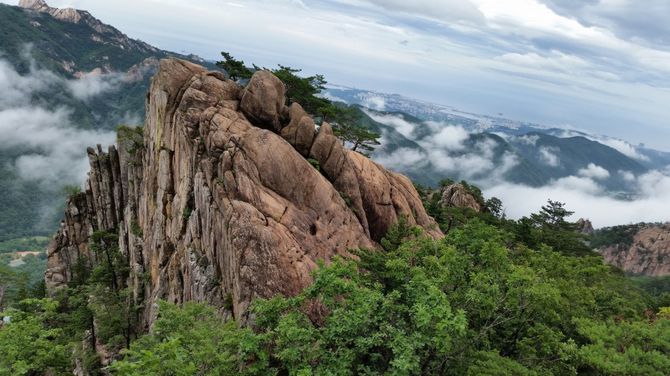
This national park is very popular with overseas visitors. The national park has a stunning, rocky landscape. The jagged peaks of the mountains rise majestically out of the surrounding pine forests. As well as beautiful mountains there are valleys filled with streams and pools and cultural sites to explore. Nature lovers will enjoy Seoraksan. The park is home to 2000 species of animal including musk deer.
The park has dozens of different hiking trails. It is really well maintained with all the routes well signposted including the distances. This makes hiking around the national park to be a very enjoyable experience.
Our recommended hike is the most popular one, the hike to Cheonbuldong Valley. It is a long but easy-going route following a trail surrounded by mountains and cliffs. The walkway is along the side of the cliff face allowing some excellent views of the valley and streams.
Ulsanbawi Rock is another popular hike. This trail takes approximately four hours. From the top the view is spectacular, taking in a number of mountains and a reservoir. Ulsanbawi is arguably the most picturesque hike in the national park and is also one of the best places to see the park’s wildlife.
10. Jeju Island
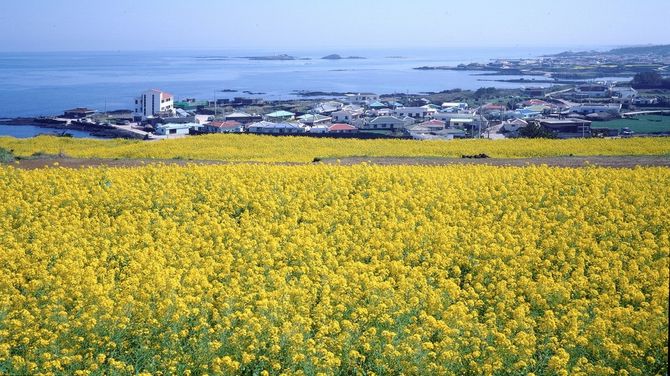
This island lies off the southern coast and is the most popular honeymoon spot in Korea. This beautiful island is dominated by the central volcano, Mount Halla. At 6,400 feet it is the highest peak in Korea.
It is popular for hiking with five different routes although only two of these actually go to the top. At the top lies Baeknok Late which lies in the crater of the volcano. It is well worth the hike to visit this beautiful place which has been classed as a UNESCO Natural Heritage Site. The two trails which reach the top are Seongpanak and Gwaneumsa.
Seongpanak is a very gentle, easy going trail but is quite long. At 9.6 km in length it is the longest trail and a round trip will take 8 hours. Gwaneumsa is shorter at 8.7 km in length and takes 7 hours for a round trip.
The beautiful natural sites are the main reason to visit Jeju. Apart from Mount Halla, a must-see the site of natural wonder is Manjanggul Lava Tube. This is a 7 km cave but public can go upto only 1 Km with inside the cave. The height of the tube is 23 meters and it was built in a manner that lava streams can run through it. This is another UNESCO Natural Heritage Site and contains the world’s largest lava column.
One of Jeju’s most famous spots is Seongsan Iichubong which is the third UNESCO site in Jeju. This is a 180 m high tuff volcano. There are 600 steps leading to the top, and it takes 25 minutes to ascend. It is recommended to visit to see the sunrise which is fabulous from the top.
There is more to Jeju than just natural sites. The island boasts three folk villages which are an excellent way to experience Korean culture. In addition, there are over ten museums on the island. These are varied ranging from a Museum of African Art to the excellent Jeju Teddy Bear Museum.
The Teddy Bear Museum is an excellent place and is highly recommended by us. With cute, interesting exhibits and friendly staff, you will have a great time there. Children especially will love it.
A strange experience can be had at Loveland. This is a sculpture park that specializes in sex sculptures. Definitely not a place to take the children, but it makes for a fun day out and for some interesting holiday snaps.
There are far too many attractions in Jeju to list here. It is a beautiful, interesting place and there is a good reason it is Korea’s number one honeymoon destination.

